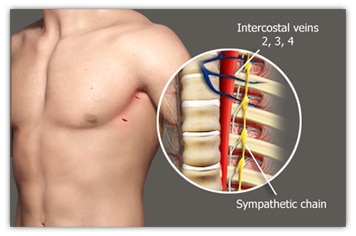TREATED CONDITIONS
Hyperhidrosis
Hyperhidrosis is abnormally increased sweating in excess of that required for regulation of body temperature. Hyperhidrosis can either be generalized or localized to specific parts of the body. Any part of the body may be affected and most common areas are hands, feet, armpits and the groin area due to the relatively high concentration of sweat glands.

Causes
Main cause of primary hyperhidrosis is unknown and secondary hyperhidrosis may develop due to a variety of medical conditions.
Treatment
Hyperhidrosis can be managed through medications or even antiperspirants and may require surgery if medications does not offer a permanent solution to the problem.
Surgical treatment for Hyperhidrosis
There are different techniques and thoracoscopic ablation is known to have excellent long term result in treatment of primary palmar (hand) and axillary (armpit) hyperhidrosis.
Thoracoscopic ablation procedure can be done as an day surgery procedure safely and efficiently under general anaesthesia.
Patient is lying down on his back with his hands up. Chest may be inflated to make more room and easy for the surgeon to visualise the sympathetic nerves.
Two small incisions of around 5mm on either side in front of the axilla (armpit) are made for the small camera (thoracoscope). The scope identifies the sympathetic nerve chain and the surgeon determines the appropriate level to block the sympathetic nerve chain. The cautery device is passed through the scope to seal the sympathetic nerve chain. Once the surgeon in happy with the procedure, the scope is withdrawn and incisions are closed.
Risks and complications
Complications are rare but may include.
- Pain in incision area.
- Bleeding
- Injury to the lungs or surrounding organs.
- Compensatory Hyperhidrosis- While the patients no longer experience excessive sweating in their palms or armpits, they often notice that they sweat more in another part of the body- chest, back, or legs.
- Pneumothorax- collection of air or gas in the chest cavity
- Horner’s syndrome or Horner syndrome is a rare complication and caused by damage to the sympathetic nervous system. This condition causes unilateral decreased facial sweating, drooping of the eyelid, and constricted pupils.